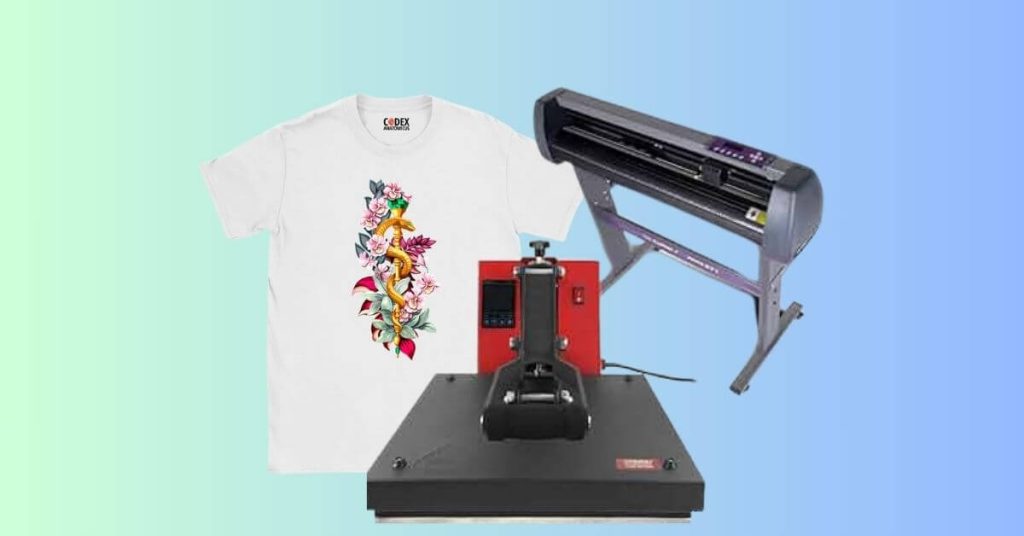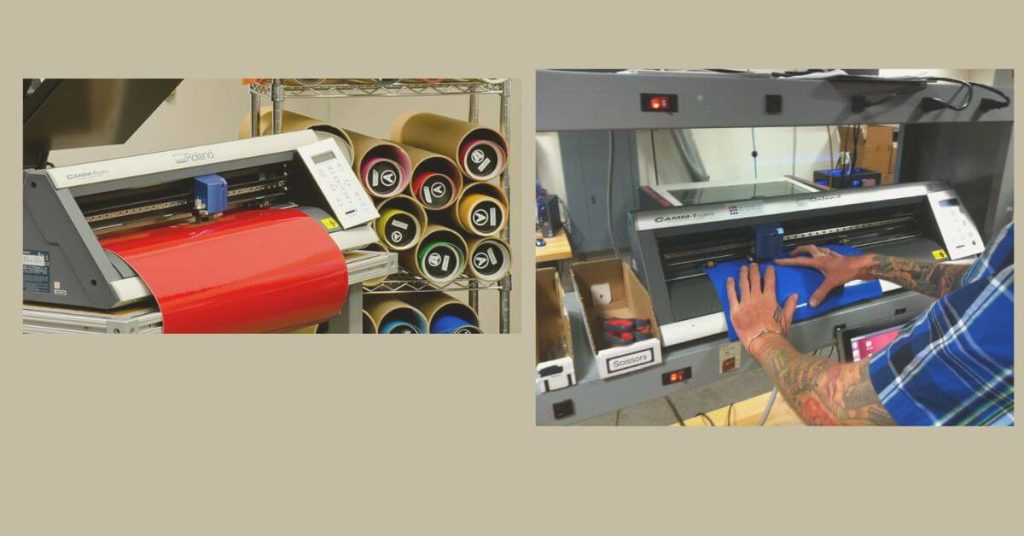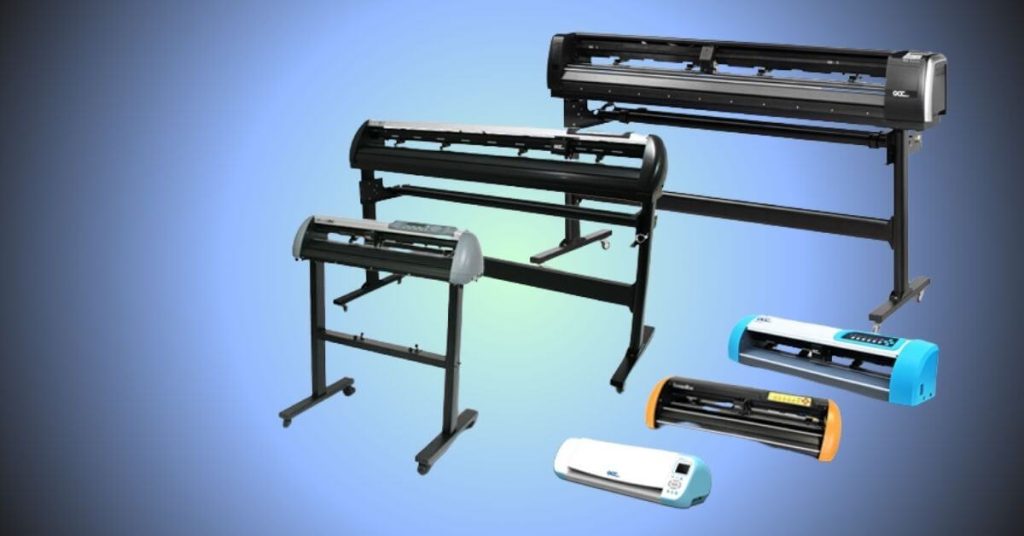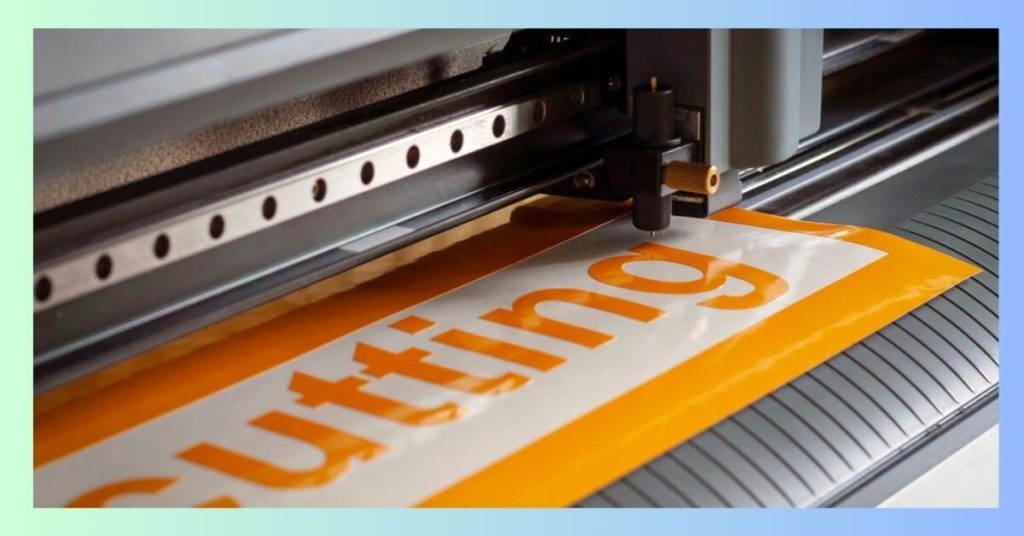By using Vinyl Cutting Machine, T-Shart Printing Business is a good idea for starting a small business business, offering precision and versatility with different materials and finishes. It’s cost-effective, allowing for on-demand production with minimal waste.
With the right tools and strategies, you can create standout personalized T-shirts and tap into this lucrative market, whether you’re an aspiring entrepreneur or a hobbyist.

The Vinyl Cutting Process
One of the most critical steps in your T-Shirt Printing Business is the vinyl cutting process. This involves designing, cutting, and applying your creations to t-shirts. Below is a step-by-step guide to help you master the process.
1. Preparing the Design
To create a standout custom T-shirt, start by designing the artwork with creativity. Choose a design tool like Adobe Illustrator, Photoshop, or Corel DRAW for detailed graphics, or opt for beginner-friendly tools like canva or Cricut Design Space.
Ensure your artwork is high-resolution and optimized for printing, with vector files being ideal for resizing without quality loss. Remember to mirror your image horizontally to ensure correct text and image orientation on the T-shirt. Adjust the size and position of your design to fit the shirt and perform a mock-up to visualize the final look.

2. Cutting and Weeding the Vinyl
To cut your heat transfer vinyl (HTV), start by placing the HTV shiny-side down on the cutting mat and loading it into your vinyl cutting machine.
Set the blade settings for your specific HTV type, load the mirrored design into the machine software, and begin cutting. After cutting, use a weeding tool to remove excess vinyl, ensuring only the desired design remains. Finally, peel off the protective film, leaving the design on its clear backing.
3. Applying the Vinyl to the T-Shirt
To transfer your design onto a T-shirt, start by laying the shirt flat on the heat press base and preheating it to remove wrinkles and moisture. Position the cut vinyl with the clear backing on the desired area, ensuring proper alignment.
Set your heat press to the appropriate temperature (300–320°F or 150–160°C) and time (10–15 seconds) for your vinyl type, and apply firm pressure. Allow the vinyl to cool slightly, then gently peel off the clear backing. If any part lifts, repress it briefly. With practice, you’ll create crisp, professional-looking custom apparel.

Business Planning
Starting a T-Shirt Printing Business with a vinyl cutting machine involves more than just creativity. Planning your business carefully will help you maximize profits and set a solid foundation for growth. Here’s a detailed guide to planning your venture.
Pricing and Payment Strategy
When pricing your products, start by calculating all costs, including materials, equipment, and labor, such as the cost of heat transfer vinyl, T-shirts, electricity, and equipment maintenance. Research and compare prices from other small T-shirt businesses to ensure competitiveness.
Consider offering discounts to attract first-time customers and encourage repeat business through loyalty rewards or bulk order incentives. Additionally, adapt to various payment options like credit cards, cash apps, and online platforms like PayPal to make transactions convenient for customers.
Marketing Strategy
To grow your T-shirt business, develop a solid marketing plan. Start by building a social media presence on platforms like Instagram, Facebook, and TikTok to showcase your designs with engaging photos and videos.
Use paid ads on social media and search engines to target potential customers.
Optimize your website with SEO keywords like “Custom T-Shirts” to improve search visibility. For a short-term strategy, focus on building a local customer base through community engagement and word-of-mouth. For long-term growth, expand your reach with an email list, online ads, and seasonal marketing campaigns.
Launching Your Business
When launching your T-shirt business, begin by leveraging personal connections to spread the word among friends, family, and colleagues, as many enjoy supporting local businesses.
Create a website to serve as your online store and portfolio, featuring high-quality images, pricing details, and an easy ordering process.
Additionally, consider selling on platforms like Etsy to gain broader exposure with minimal setup costs, reaching customers beyond your local area.
Related post : How to Set Up a Vinyl Cutting Machine for Small Business Success.

Tips for Success
To help your T-shirt business thrive, invest in quality materials and equipment to ensure your products are durable and appealing, building customer trust.
Budget wisely by comparing prices for supplies and equipment to save money without sacrificing quality.
Focus on a specific niche or target audience initially, like event T-shirts or sportswear, and expand as your business grows. Stay organized with scheduling tools and project management apps to manage orders and maintain excellent customer service.
Experiment with new ideas by keeping up with design trends to keep your offerings fresh and exciting. These steps will set your business up for both short-term success and long-term growth.
Production Process
Creating a high-quality custom t-shirt involves a series of steps that ensure precision and professionalism. Below is a breakdown of the production process from start to finish.
1. Cutting the Vinyl
To start the production process by cutting your design from heat transfer vinyl (HTV), first set up your vinyl cutter by loading the HTV shiny-side down onto the cutting mat and feeding it into the machine, like a Cricut Maker or Silhouette Cameo.
Adjust the machine settings according to the vinyl type; thicker materials may need a deeper blade depth and slower speed. Upload your mirrored design to the software, align the cutting area, and begin cutting, ensuring the blade is sharp for precise results.
2. Weeding the Design
After cutting the design, the next step is weeding, which involves removing excess vinyl. Start by laying the HTV on a flat surface and using a weeding tool to gently lift away the extra material.
Begin with larger areas around the design’s edges, then move to the smaller, intricate details. Be patient with detailed designs to avoid mistakes, and use good lighting or a magnifying lamp to make the process easier.
3. Applying the Design
To transfer your weeded design onto a T-shirt using a heat press, first lay the shirt flat on the press and preheat it briefly to remove wrinkles and moisture.
Align the design on the shirt using a ruler for accuracy. Set the heat press to the correct temperature and time for your vinyl type, then apply consistent heat and pressure to bond the vinyl securely to the fabric.
4. Quality Control
The final step in production is ensuring your t-shirts meet quality standards. Start by inspecting the design for defects like incomplete vinyl adhesion, wrinkles, or misaligned graphics.
Test durability by gently tugging at the vinyl edges to confirm it’s securely attached, ensuring it withstands washing and wearing.
Finish by folding or packaging the t-shirt neatly for delivery, presenting a professional appearance. Mastering these steps ensures your custom t-shirts are high-quality and durable, helping build a reputation for excellence in your business.
Setting Up a Workspace
Creating a well-organized and safe workspace is essential for running an efficient and professional t-shirt printing business. Here’s how you can set up your workspace to maximize productivity while ensuring safety and compliance.
Organizing a Functional Workspace
A streamlined workspace boosts efficiency and reduces errors. To achieve this, designate specific zones for each production step, like design preparation and heat pressing, to maintain a smooth workflow.
Position equipment like vinyl cutters and heat presses on sturdy tables with easy access to frequently used tools. Use shelves, bins, and pegboards for organized storage of supplies, ensuring everything is labeled.
Bright, adjustable lighting is crucial for tasks requiring precision, such as weeding intricate designs. These strategies create an organized environment that enhances productivity.
Ensuring Safety and Compliance
Prioritizing safety in your workspace is crucial for efficient production and protecting your team and investment. Ensure proper ventilation to manage heat and fumes from heat presses, using open windows, fans, or air filtration systems.
For electrical safety, plug machines into grounded outlets, use surge protectors, and regularly inspect cords for damage. Maintain a clean workspace by promptly clearing debris to prevent accidents and enhance efficiency.
Comply with local regulations by checking safety standards and zoning rules, especially if operating from home. Keep a fire extinguisher nearby and avoid flammable items near heat-generating equipment. By organizing your workspace with safety in mind, you create a solid foundation for success in your T-shirt printing business.
Marketing and Sales Strategies
To run a successful T-shirt printing business, you need more than creative designs and quality products — you need smart marketing and sales strategies. Here’s how to promote your business effectively and connect with your target audience.
Building an Online Presence
- Building a strong online presence is essential in today’s market. Start by creating a professional website that acts as your digital storefront, featuring high-quality images, detailed product descriptions, and a simple ordering process.
Enhance credibility with a blog or customer testimonials. Leverage social media platforms like Instagram and Facebook to showcase your designs through engaging visuals, behind-the-scenes content, and customer reviews.
Consistently engage with your audience by responding to comments, participating in trends, and collaborating with influencers.
- Expand your reach by utilizing online marketplaces like Etsy or eBay to access a global audience. Additionally, participate in local events such as craft fairs and farmers’ markets to connect with local customers and gather feedback.
Consider partnerships with local businesses for custom printing services to build professional relationships and secure bulk orders. These strategies will help you grow your T-shirt printing business and establish a loyal customer base.
Implementing Promotional Strategies
Attracting and retaining customers in the T-shirt printing business requires creative promotional strategies. Consider offering discounts and deals, such as introductory offers or “Buy Two, Get the Third Free” promotions, to entice new customers.
Implement loyalty programs to reward repeat customers with exclusive discounts or free shipping, boosting retention and encouraging referrals. Tailor seasonal campaigns around holidays, promoting themed T-shirts through social media and email marketing to increase sales.
Additionally, offer referral incentives to encourage satisfied customers to bring in new business. By combining these strategies with a strong online presence and diverse selling channels, you can grow your business and build lasting customer relationships.
Overcoming Challenges
Every business comes with its set of challenges, and T-shirt printing is no different. Addressing these hurdles head-on can help you create a smoother workflow and build a stronger, more competitive business. Below are practical tips to help you overcome some common obstacles.
1. Production Bottlenecks
Efficient order and production management is key to meeting deadlines and ensuring customer satisfaction.
Plan ahead by using a calendar or project management tool to schedule tasks like cutting, weeding, and printing, prioritizing orders by deadlines and allowing buffer time for unexpected issues.
Streamline inventory management by maintaining an up-to-date stock of materials and categorizing inventory by type, color, and size. Leverage tools like Trello, Excel, or specialized order management systems to track production status and time spent on tasks, helping you identify bottlenecks and make necessary adjustments for a smoother operation.
2. Maintaining Quality
Delivering high-quality products is crucial for customer satisfaction and long-term success. To maintain consistency and reduce issues with returns, invest in reliable materials and equipment from reputable suppliers.
This ensures durability and vibrancy in your designs. Follow best practices by adhering to recommended heat press settings and testing designs on samples before bulk production. Implement a thorough quality control process to inspect each product. Additionally, provide clear care instructions with every order to help customers maintain their T-shirts, reflecting your attention to detail and enhancing customer trust in your brand.
3. Competition in the Market
In the competitive T-shirt printing industry, carving out your niche is key to attracting loyal customers.
Focus on a specific audience or theme, like humorous designs or sports apparel, to differentiate yourself. Create unique designs that reflect your brand’s identity and offer personalized options for customization.
Deliver superior customer service by responding promptly and providing regular updates, turning one-time buyers into loyal supporters. Expanding your product range to include items like tote bags and hoodies can also boost your sales potential. By addressing challenges proactively, you can position your business for success and growth in the market.
Tips for Scaling Your Business
Expanding Your Product Line
Expanding your T-shirt printing business by diversifying your product line can unlock new growth opportunities.
By offering related products like caps, tote bags, mugs, and hoodies, you can attract a wider audience and create additional revenue streams. Incorporating various printing methods, such as screen printing, sublimation, and direct-to-garment (DTG) printing, enhances your versatility and appeal to different customer needs.
This strategic diversification not only boosts your earning potential but also strengthens your market position, making your business a go-to provider for custom printing services.
Automating Operations
Running a T-shirt printing business involves managing a variety of tasks, from creating designs to handling customer orders and ensuring timely deliveries.
Automation can be a game-changer in streamlining these operations, saving you time and reducing manual effort. Here’s how you can use apps and software to make your business run more smoothly.
Streamlining Design Mockups
Automation tools can streamline the creation of professional mockups for your customers. Design software like Canva, Adobe Illustrator, and Place It offer pre built templates for easy mockup creation.
Customizable mockup generators, such as those from Printify or Printful, integrate with your storefront to automate previews, helping customers visualize their purchases before ordering.
Automating Invoicing and Payment Processing
As your business expands, managing invoices and payments manually can be daunting. Automation tools like QuickBooks, Wave, or FreshBooks can automatically generate and send invoices, while tracking payment statuses.
Integrating payment gateways such as PayPal, Stripe, or Square ensures secure, seamless transactions, enhancing the customer experience and keeping your finances organized.
Improving Customer Communication
Effective communication is key to customer satisfaction, and automation can ensure you never miss a message. CRM tools like HubSpot or Zoho help track conversations and automate personalized follow-ups. Chatbots, such as those powered by Tidio or ChatGPT, can handle common queries and provide instant customer interaction. Additionally, apps with automated order updates keep customers informed about their purchase status, reducing inquiries and enhancing the overall shopping experience.
Simplifying Shipping Processes
Efficient shipping is crucial for customer satisfaction, and automation tools can simplify the process. Shipping integration software like Ship Station or Easy Ship can automate label printing, calculate shipping rates, and provide real-time shipment tracking. Additionally, automating inventory and fulfillment management helps prevent overselling or understocking. Platforms like Shopify or Woo Commerce offer features to integrate inventory tracking with shipping providers, ensuring a smooth and efficient operation.
The Benefits of Automation
Leveraging automation offers several advantages for your business. It saves time by reducing repetitive tasks, allowing you to focus on growth and creativity. Automation also minimizes errors in critical functions like invoicing and inventory management. Enhanced customer satisfaction comes from faster response times, clear communication, and efficient order processing. Many automation tools are budget-friendly, making them accessible for small businesses. By automating, you create a more efficient and scalable operation, paving the way for long-term success in your T-shirt printing business.
Fostering Customer Loyalty
Building strong relationships with your customers is key to creating a sustainable and successful T-shirt printing business.
Loyal customers not only return for repeat purchases but also spread the word about your brand, helping you grow organically. Here are some practical ways to foster customer loyalty.
Run Promotions and Offer Discounts
Promotions are a great way to attract both new and returning customers. Seasonal sales during holidays or events can create excitement and drive purchases.
Offering bulk order discounts is effective for attracting corporate clients or groups needing matching apparel, rewarding larger purchases and securing long-term customers
Create Reward Programs
A well-crafted reward program can enhance customer retention by making them feel valued. Implement a loyalty points system where customers earn points with each purchase, redeemable for discounts or free products.
Offer exclusive perks like early access to new designs, special offers, or free personalization. These gestures not only show appreciation but also create a sense of belonging, encouraging repeat business.
Leverage Customer Reviews and Testimonials
Word-of-mouth is a powerful tool for building trust and credibility. Encourage customer feedback by requesting reviews after orders and showcase glowing testimonials on your platforms, including photos for relatability.
Respond thoughtfully to all reviews to show you value their experience. Personalizing interactions, like including thank-you notes or tailored recommendations, strengthens connections with customers. These strategies improve satisfaction, foster loyalty, and turn customers into advocates for your brand, driving business growth.
Summary of opportunities and growth tips for T-shirt printing business.
Starting a T-shirt printing business with a vinyl cutting machine offers great potential, even with minimal investment. Begin small, focus on producing quality designs, and provide excellent customer service.
Grow steadily by mastering basics and scaling as demand rises. Stay adaptable by tracking trends, experimenting with products, and listening to customer feedback. With dedication and creativity, you can build a unique brand and thrive in the custom apparel market.

Leave a Reply
You must be logged in to post a comment.